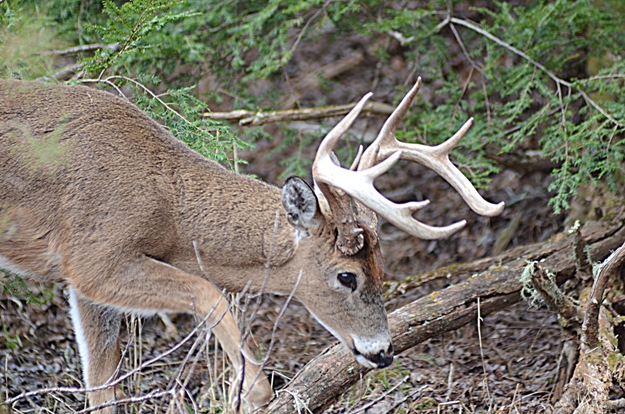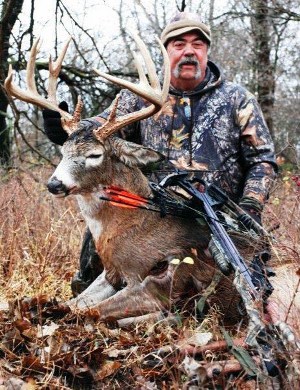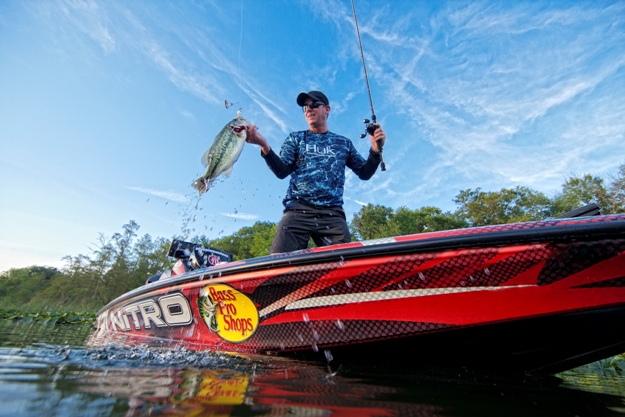“What state consistently has produced the most big bucks for you?”

All the states I've mentioned – Georgia, Illinois, Iowa, Kansas, Missouri, New York - have the potential to produce really big bucks in any year. However, I've been most consistently successful in Kansas.
The place I hunt has plenty of agricultural fields, including hundreds of cornfields, soybean fields and milo fields. This area doesn’t have a lot of woods. So, I look for river bottoms with thick cover, a shelter belt, CRP land, small woodlots or grown-up fence lines where you usually can find rubs and scrapes. Determining what the bucks are doing, and when they're doing it makes patterning mature bucks much easier and quicker than when you're hunting large woodlots.
Often there will be a good number of bucks in these little places, because there is nowhere else for them to hide. I'm hunting small sites, and I’ve found that bowhunting is much easier and often more successful when a big buck only has 20 to 30 yards to your left or to your right where he can walk without being in an agricultural field.
The biggest buck I've ever taken in Kansas scored 177 inches. In the spot where I took the 177-inch buck, I’d missed a buck the previous year that would’ve scored 160 on Pope and Young. That was the first year I’d hunted in Kansas, and I didn’t harvest a buck that first year. But the numbers and the sizes of older-age-class bucks that I saw on that hunt totally convinced me to add Kansas to my hunt schedule. So, the next year I knew where to start looking for a trophy-class buck.
 Once I arrived in Kansas that next year, I went right back to the same spot where I’d missed the big 160-inch buck. I got in my climbing tree stand and let the woods settle for about 20 minutes. Then, I blew my Quaker Boy grunt call. As soon as I blew that grunt call, this big buck came running straight in to my tree stand. When he winded me, he was 7 to 8 yards from the base of my tree. A big tree with a very big rub was out in front of my stand, and I had ranged that tree at 17 yards. So, as soon as the buck smelled me, I drew my bow. When the buck got to the tree with the big rub on it, he stopped, looked back, and I released the arrow.
Once I arrived in Kansas that next year, I went right back to the same spot where I’d missed the big 160-inch buck. I got in my climbing tree stand and let the woods settle for about 20 minutes. Then, I blew my Quaker Boy grunt call. As soon as I blew that grunt call, this big buck came running straight in to my tree stand. When he winded me, he was 7 to 8 yards from the base of my tree. A big tree with a very big rub was out in front of my stand, and I had ranged that tree at 17 yards. So, as soon as the buck smelled me, I drew my bow. When the buck got to the tree with the big rub on it, he stopped, looked back, and I released the arrow.
When the buck took the arrow, he took off and ran about 200 yards from my tree. Then, he jumped in a river. When he came out of the water on the other side of the river, I saw that the water behind him was red. He only went a few steps before he stopped and fell over.
I wasn’t able to recover that deer for five hours after I shot him, because he was on another landowner’s property. I got with a buddy of mine who lives in that area, and he helped me get permission from the landowner to retrieve my buck. During that time, I was very nervous and anxious. I was worried that someone else would find my buck before I could get to him, and he wouldn’t be where I’d seen him go down.
Seeing all those mature bucks the first time I hunted Kansas, and then taking a 177-class buck the second time I released an arrow in Kansas, confirmed my belief in the state. That’s why I go there to bowhunt deer every year.
Day 2: Why Ernie Calandrelli Hunts Where He Does
Tomorrow: Seeing 13 Bucks in 90 Minutes




























